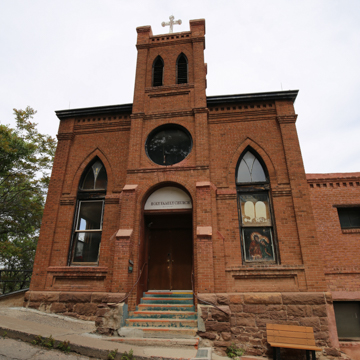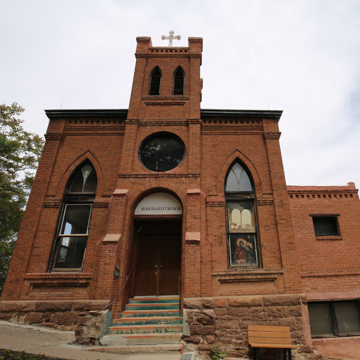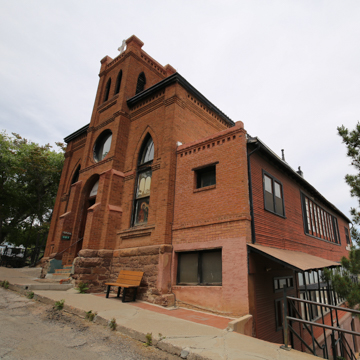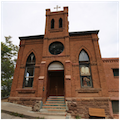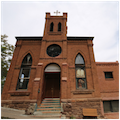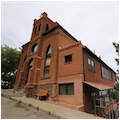Considered the second oldest congregation in Jerome, formed in 1896, and the oldest within the current Phoenix Diocese, the Holy Family Catholic Church was originally placed under the Prescott Diocese and was administered by priests traveling from Prescott. Colloquially called the “miners’ church,” its epithet reflected the congregation’s largely Hispanic and European immigrant ancestry. Completed in 1900, this Gothic Revival ecclesiastical edifice is the second manifestation of the Holy Family Catholic Church. The first—a frame building on Giroux Street—was destroyed by the 1898 fire, prompting the congregation to rebuild with masonry. At the time of its construction, it cost $20,000.
Built into a precipitous hill, the three-story church looms above Main Street but displays only one lofty story on its County Road facade. Brick walls rise from a rough-hewn stone foundation; while the rear elevation is largely blind, it features decorative brick pilasters, belt courses, and the ghosts of former apertures. The facade and side elevations are ornamented with brick pilasters, bands, and a patterned brick cornice. The east elevation is obscured by a one-story concrete, brick, and wood-frame addition. The symmetrical, rectangular footprint features a projecting centralized, square tower on the facade that rises above the flat roof; it holds a pointed-arch entryway flanked by buttresses, a rose window above, and pairs of pointed-arch apertures on all four sides of the tower. Pointed-arch windows with etched and stained glass flank the entrance and march down the side elevations. The interior features wood floors, pressed-metal walls and ceilings painted white and accented by blue and gold trim, and an ornate altarpiece. The St. Louis–based Kilgen and Sons Pipe Organ Company designed an organ model specifically for small churches in the early 1900s and the Holy Family Catholic Church’s organ is one of only three extant, the most famous found in Manhattan’s St. Patrick’s Cathedral.
With the United Verde Mine’s closure in 1953, the congregation quickly dwindled and the building fell into disuse and disrepair. When the final resident priest, Franciscan Father Juan Atucha Gorostiaga, passed away in 1979, the townspeople discovered $8,000 in coins and small bills that he had amassed. They used the funds to restore the interior in 1980, repainting the altar and sanctuary and repairing the pipe organ. It was reopened as a retreat center for Catholic groups. Unfortunately, a rainstorm in 1981 damaged the roof and subsequently well-meaning but overzealous seminarians painted over the original golden images of the Holy Ghost and Eye of God on the altar and removed old window paintings in the sanctuary in the 1990s. Today, the rear elevation is structurally unsound, its stone foundation crumbling and the mortar in need of repointing. Restoration efforts by private citizens are underway, and the church remains open to the public.
References
Ettenborough, Kelly. Arizona’s Sanctuaries, Retreats, and Sacred Places. Boulder, CO: Big Earth Publishing, 2002.
Rapaport, Diane Sward. “New life for Jerome’s Holy Family Catholic Church (with photo gallery): Once-a-month mass breathes life into historic church.” Verde Independent (Arizona), November 19, 2014.
Young, Herbert V. They Came To Jerome: the Billion Dollar Copper Camp. Jerome, AZ: Jerome Historical Society with Bird Printing, 1989.

